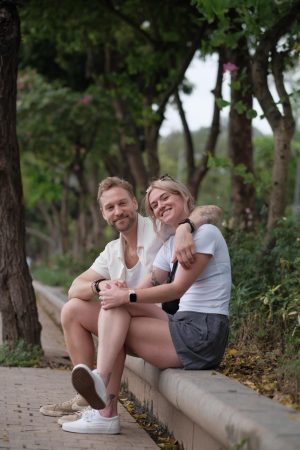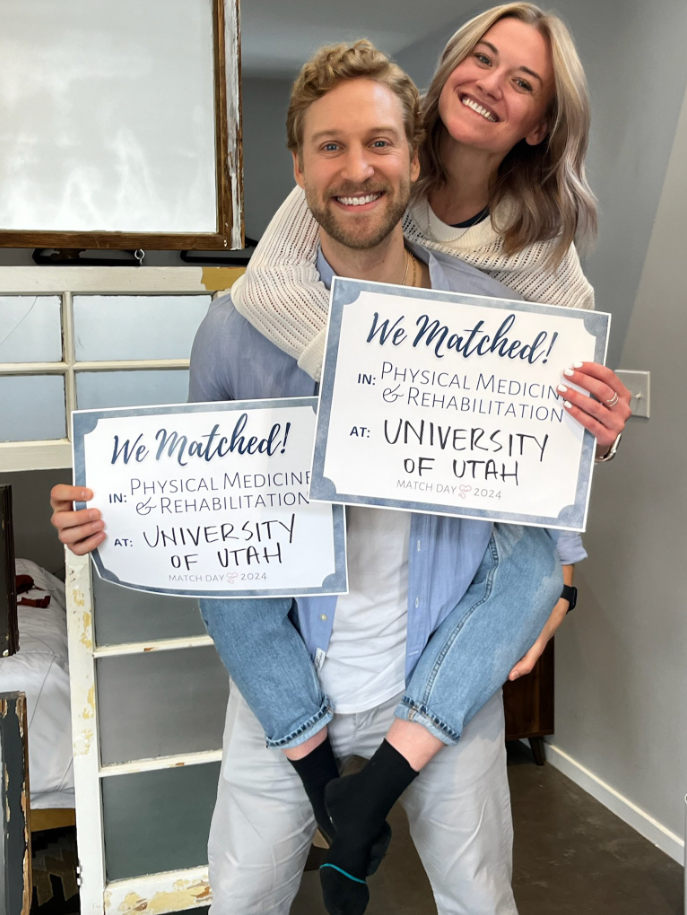Daniel Persson, DO, MBA, is a recent graduate of Ohio University Heritage College of Osteopathic Medicine (OU-HCOM). Persson and his partner, Sophie Andrews, MD, participated in the 2024 National Resident Matching Program Match as a couple. In July, the two began residency at their first choice: the Physical Medicine and Rehabilitation (PM&R) program at the University of Utah.
During the two years following undergrad, I was working as a certified personal trainer, and I loved it. I felt like I was making a real impact on my clients, encouraging a healthy lifestyle. I ended up working with a man with cerebral palsy, which was inspiring and eye-opening. He wanted to improve his function, increase his ability to perform daily tasks, and become more independent. As his trainer, I helped him build a more self-sufficient life. I realized I’d found my purpose.

During this time, I shadowed a PM&R physician, who told me about the role and its impact on every aspect of patient care. Those words resonated with me, and after that day, I knew I wanted to become a physiatrist!
While researching medical schools, I learned that osteopathic medicine was the career path for me. I was drawn to the emphasis on holistic care, the robust musculoskeletal training, and the opportunities to perform osteopathic manipulative treatment (OMT). (I went on to develop a passion for OMT, earning the nickname “The OMT Guy” and becoming president of the Student American Academy of Osteopathy at OU-HCOM.)
During my third year at OU-HCOM, I was lucky enough to travel to Anaheim, California for the Association of Academic Physiatrists Annual Conference. I was on the Medical Student Council for this organization and was also presenting a research poster. It was there that I met Sophie, an MD student at Oregon Health and Science University! We attended the same lecture, and I tried to impress her and the many program directors in the room by answering many questions and offering my opinion as a medical student. I lost her in the crowd as the lecture ended, but I ran into her at a networking event that same evening. We spent the rest of the conference together and even went to Disneyland together on the last day of the conference! We joke that Disneyland was our first date. We have been a nerdy physiatry couple ever since.
Also, during my third year, I was preparing to take COMLEX-USA Level 2-CE. While a little voice in the back of my head was urging me to repeat what I’d done previously with COMLEX-USA Level 1 and USMLE Step 1 to get high scores (this was prior to pass/fail), I really did not want to relive that experience. I’d prepared for both with such an intense study regimen that it ended up taking a significant toll on my mental health.
After speaking to numerous PM&R program directors, residents, and my residency advising team, no one was telling me that I had to take Step 2. So why put myself through the extra stress and financial burden of taking an extra exam? Two months later, I received my COMLEX-USA Level 2-CE score of 629 (85th percentile). I was so proud!
(Recently, leadership in PM&R issued a consensus statement encouraging program directors to consider COMLEX-USA scores when evaluating DO candidates.)

As Sophie and I entered our fourth year of medical school, we were excited to embark on the ERAS (Electronic Residency Application Service) journey together. Our situation was a little more unique than the typical couples who match together; PM&R is a very small specialty with only one program in most cities, and most of those have very small cohorts. Essentially, we would have been in the same program! Our strategy was to focus on cities that have multiple PM&R programs.
To add extra spice into the mix, PM&R residencies have both categorical (all four years in one location) and advanced (one intern year at a program and then three years of PM&R at a different program) positions. Thus, we also had to juggle internal medicine preliminary year and transitional year applications. We wanted to try to spend all four years together, but with those advanced programs, it was never a guarantee. We ended up applying to the same PM&R programs and intern-year programs.
As we applied, we were both anxious about holding the other one back. What if one of us got an interview at a program and the other didn’t? Since most cities only had one program, this was a frequent thought for both of us. We were very confident in our applications and knew that if we both were able to get an interview, we would be able to showcase ourselves as a power couple.
We both ended up with a lot of PM&R interviews, most in the same program or city! We tried our best to show the programs that we were top candidates and to consider us as a package deal. As our interviews began wrapping up, we started creating our rank list. Our approach went like this:
- We both took our own notes about each program
- We created our own rank list
- We compared our lists
- We submitted our final list for certification
Our lists were very similar, as we both valued things like location, categorical vs advanced, fellowship opportunities, resident vibes, and more. We both cared so deeply about the other person’s experience that it was easy to be flexible and come to an agreement on our final list.
Leading up to Match Week, we were both so confident in our individual applications and the Daniel-Sophie package deal, but anxiety was still high. We were excited to learn that we had both matched to our first choice—PM&R at the University of Utah in Salt Lake City! The strong categorical program was perfect for us, and the robust academic center has everything we need to be successful in our training. We’ll also be together for the next four years in the heart of the mountains—meaning that when we aren’t busy improving patients’ functions, we will be busy exploring the outdoors!
We’re both excited to explore the different aspects of PM&R in more detail. These next four years are going to test our resolve, our academic prowess, and our relationship—and we are very much up for the challenge!

